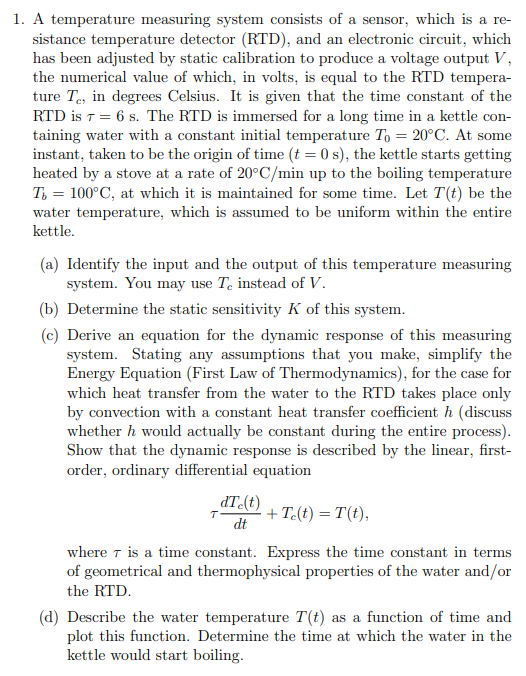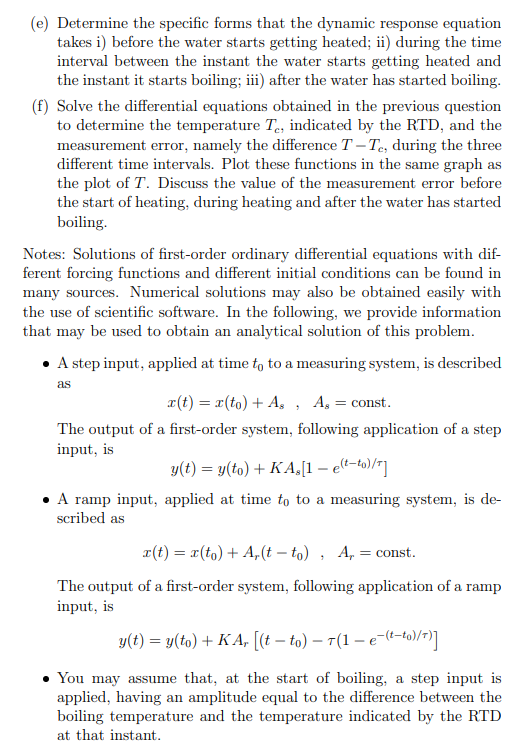Answered step by step
Verified Expert Solution
Question
1 Approved Answer
1. A temperature measuring system consists of a sensor, which is a re- sistance temperature detector (RTD), and an electronic circuit, which has been


1. A temperature measuring system consists of a sensor, which is a re- sistance temperature detector (RTD), and an electronic circuit, which has been adjusted by static calibration to produce a voltage output V, the numerical value of which, in volts, is equal to the RTD tempera- ture Te, in degrees Celsius. It is given that the time constant of the RTD is 7 = 6 s. The RTD is immersed for a long time in a kettle con- taining water with a constant initial temperature To = 20C. At some instant, taken to be the origin of time (t = 0 s), the kettle starts getting heated by a stove at a rate of 20C/min up to the boiling temperature T =100C, at which it is maintained for some time. Let T(t) be the water temperature, which is assumed to be uniform within the entire kettle. (a) Identify the input and the output of this temperature measuring system. You may use Te instead of V. (b) Determine the static sensitivity K of this system. (c) Derive an equation for the dynamic response of this measuring system. Stating any assumptions that you make, simplify the Energy Equation (First Law of Thermodynamics), for the case for which heat transfer from the water to the RTD takes place only by convection with a constant heat transfer coefficient h (discuss whether h would actually be constant during the entire process). Show that the dynamic response is described by the linear, first- order, ordinary differential equation dTc(t) dt + Te(t) = T(t), where 7 is a time constant. Express the time constant in terms of geometrical and thermophysical properties of the water and/or the RTD. (d) Describe the water temperature T(t) as a function of time and plot this function. Determine the time at which the water in the kettle would start boiling. (e) Determine the specific forms that the dynamic response equation takes i) before the water starts getting heated; ii) during the time interval between the instant the water starts getting heated and the instant it starts boiling; iii) after the water has started boiling. (f) Solve the differential equations obtained in the previous question to determine the temperature T, indicated by the RTD, and the measurement error, namely the difference T-Te, during the three different time intervals. Plot these functions in the same graph as the plot of T. Discuss the value of the measurement error before the start of heating, during heating and after the water has started boiling. Notes: Solutions of first-order ordinary differential equations with dif- ferent forcing functions and different initial conditions can be found in many sources. Numerical solutions may also be obtained easily with the use of scientific software. In the following, we provide information that may be used to obtain an analytical solution of this problem. A step input, applied at time to to a measuring system, is described as x(t) = x(to) + As, A, = const. The output of a first-order system, following application of a step input, is y(t) = y(to) + KA,[1 - e(t-to)/T] A ramp input, applied at time to to a measuring system, is de- scribed as x(t) = x(to) + A,(t-to), A = const. The output of a first-order system, following application of a ramp input, is y(t) = y(to) + KA, [(t to) - T(1 e(t-to)/T)] You may assume that, at the start of boiling, a step input is applied, having an amplitude equal to the difference between the boiling temperature and the temperature indicated by the RTD at that instant.
Step by Step Solution
There are 3 Steps involved in it
Step: 1

Get Instant Access to Expert-Tailored Solutions
See step-by-step solutions with expert insights and AI powered tools for academic success
Step: 2

Step: 3

Ace Your Homework with AI
Get the answers you need in no time with our AI-driven, step-by-step assistance
Get Started


